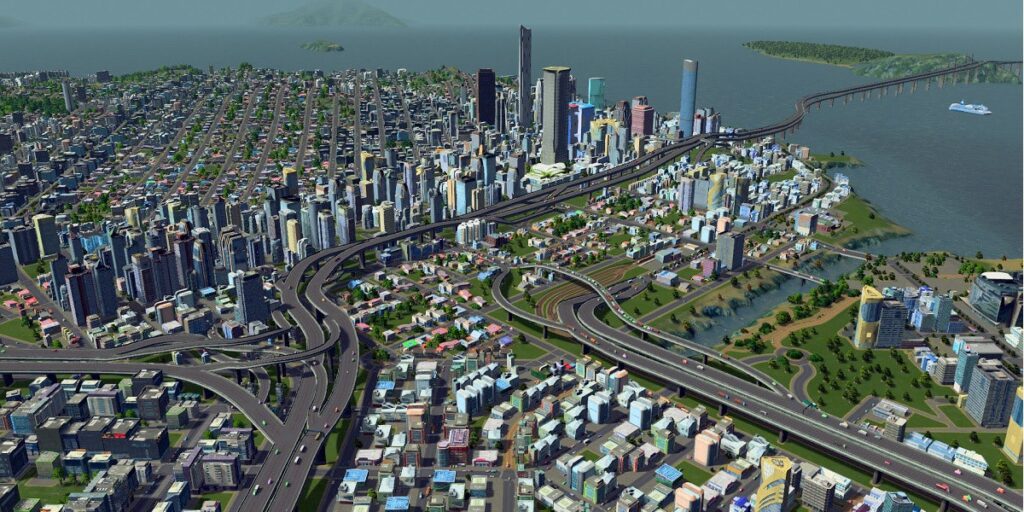Cities: Skylines, a city building simulation game, allows players to create and manage their own virtual city with residential, commercial, and industrial zones, road networks, public services, and more. The game mechanics and the basics required to build a city in the game include understanding the zoning, infrastructure, public services, and managing budgets. Players can choose their starting location and follow the key steps of building a city, including setting up road networks, zoning residential, commercial, and industrial areas, providing public services, building parks and leisure facilities, and managing budgets. Advanced techniques include using mods and custom content, building custom interchanges, experimenting with different building styles, and using landscaping and terrain editing.
How to Build Your Own Virtual City in ‘Cities: Skylines’
Cities: Skylines is a city building simulation game that was released in 2015. It allows players to create and manage their own virtual city, complete with residential, commercial, and industrial zones, road networks, public services, and much more. In this article, we will guide you through the steps of building your own city in Cities: Skylines.
Step 1: Understanding the Basics
Before we start building our city, it’s important to understand the basic concepts and mechanics of the game. Here are some key points to keep in mind:
- Residential zones are where your citizens live.
- Commercial zones are where businesses are located.
- Industrial zones provide jobs and resources.
- Infrastructure, such as roads and public transport, is key to supporting the growth of your city.
- Public services such as police stations, fire stations, and hospitals are important for keeping your citizens safe and healthy.
- Managing your city’s budget is crucial to its success.
Step 2: Choosing Your Starting Location
When you start a new game in Cities: Skylines, you’ll need to choose your starting location. You can either select an existing map or generate a random one. Look for a location that has a variety of terrain and natural resources, as well as easy access to water and transportation.
Step 3: Building Your City
Now that you have a basic understanding of the game mechanics and have chosen your starting location, it’s time to start building your city. Here are the key steps to follow:
1. Set Up Your Road Network
The road network is the backbone of your city, so it’s important to get it right. Start by building a few main roads that connect different parts of the city, and then add smaller streets and avenues as needed. Use roundabouts and intersections to manage traffic flow, and avoid building too many dead-end streets.
2. Zone Residential, Commercial, and Industrial Areas
Once your road network is in place, it’s time to start zoning different areas of the city. Click on the “Zoning” tool and select either residential, commercial, or industrial zones. The game will automatically fill in the appropriate buildings based on the demand for each type of zone.
3. Provide Public Services
As your city grows, it will need more public services to keep your citizens happy and healthy. Build police stations, fire stations, hospitals, and schools to provide those services.
4. Build Parks and Leisure Facilities
Parks, beaches, and other leisure facilities are important for keeping your citizens happy and healthy. Build them near residential areas to boost property values and prevent pollution.
5. Manage Your Budget
As your city grows, so will its expenses. Make sure to keep an eye on your budget and adjust taxes and spending as needed. Be careful not to overspend, or you’ll end up in debt.
Step 4: Advanced Techniques
If you’re ready to take your city building skills to the next level, here are some advanced techniques to try:
1. Use Mods and Custom Content
Cities: Skylines has a vibrant modding community, and there are countless mods and custom content available to enhance your game. From new buildings and vehicles to gameplay modifications and user interface improvements, there’s something for everyone.
2. Build Custom Interchanges
Interchanges are the junctions where different roads and highways intersect. Building custom interchanges can be challenging but rewarding, and it can greatly improve traffic flow in your city.
3. Experiment with Different Building Styles
Cities: Skylines allows you to experiment with different building styles and architectural trends. Try building a European-style city with narrow streets and cozy cafes, or a futuristic megacity with towering skyscrapers and flying cars.
4. Use Landscaping and Terrain Editing
Landscaping and terrain editing tools allow you to sculpt the terrain and create natural features like rivers, lakes, and mountains. Use them to create scenic vistas and unique landscapes that enhance the beauty of your city.
Conclusion
Building your own virtual city in Cities: Skylines is a fun and rewarding experience that requires planning, creativity, and patience. By following the steps outlined in this article and experimenting with advanced techniques, you can create a thriving metropolis that reflects your personal style and vision. So go forth and start building!
